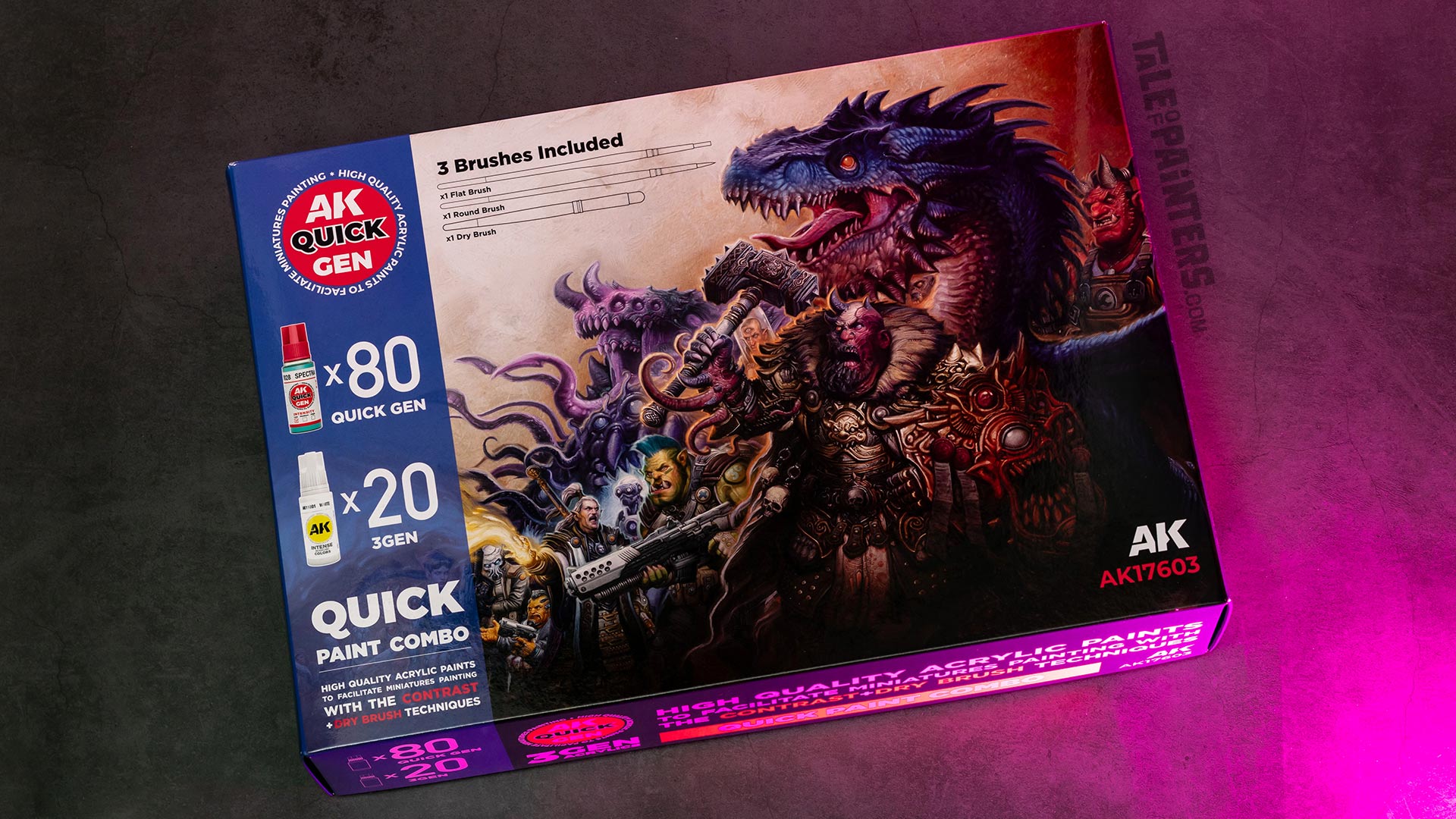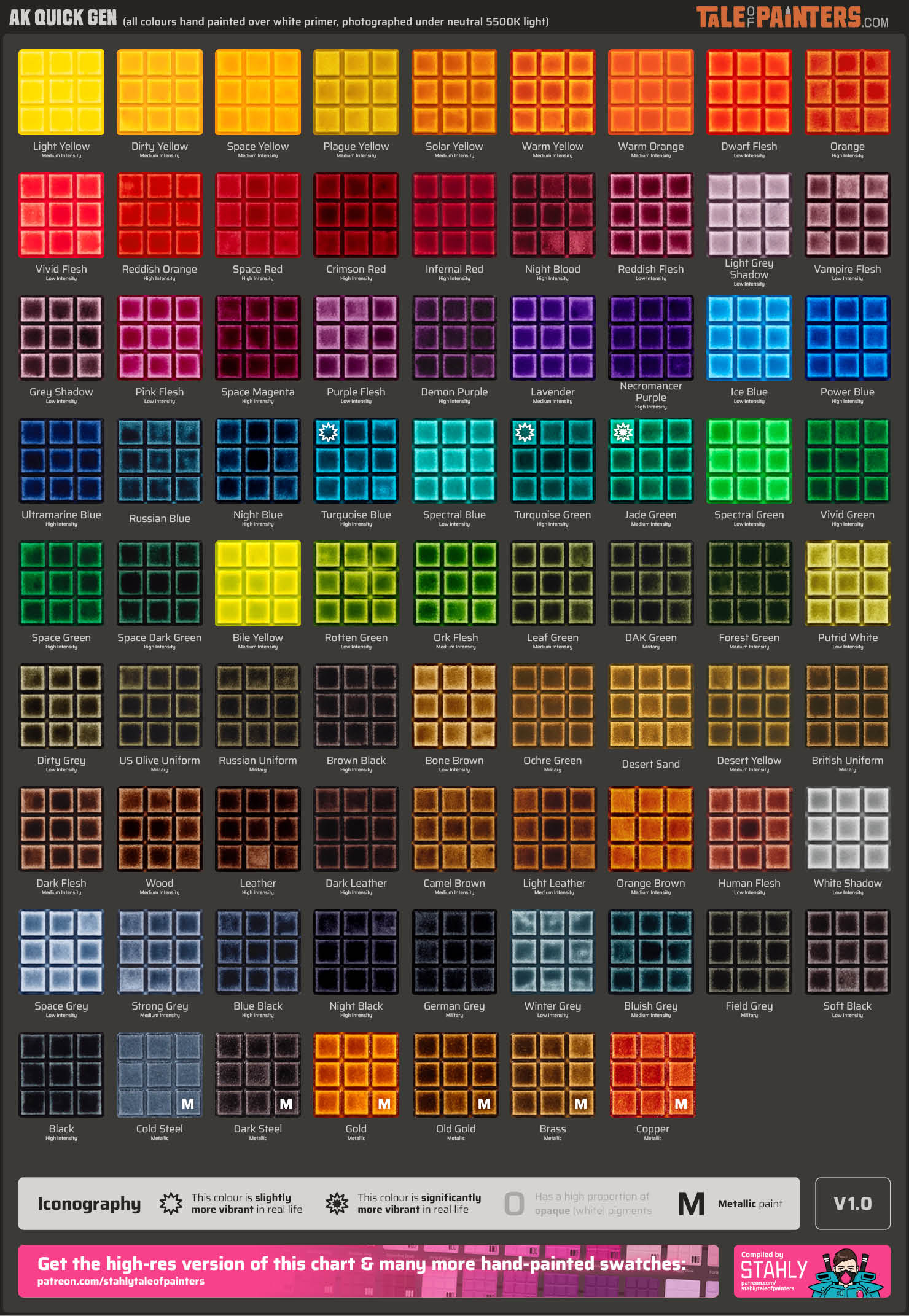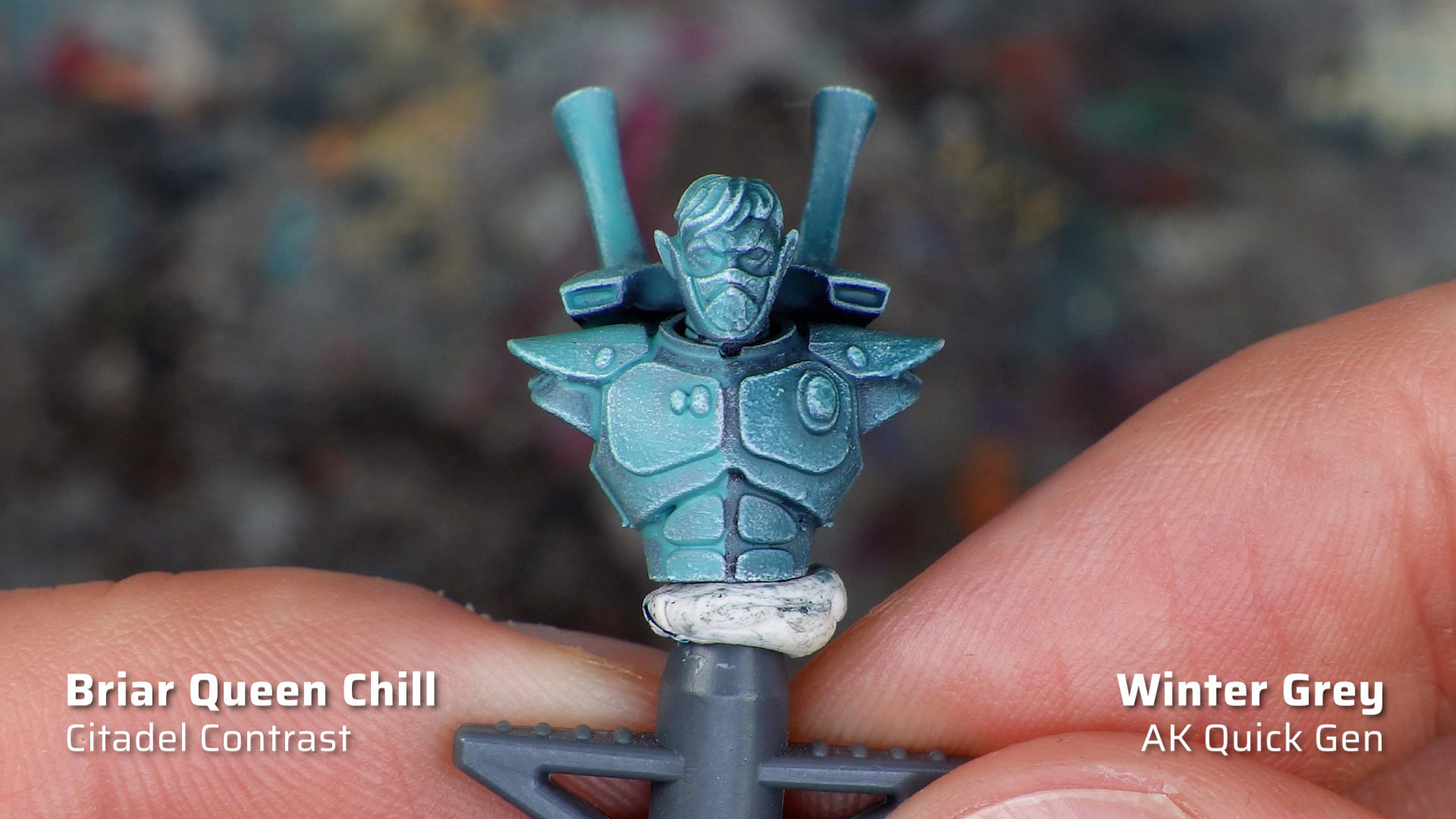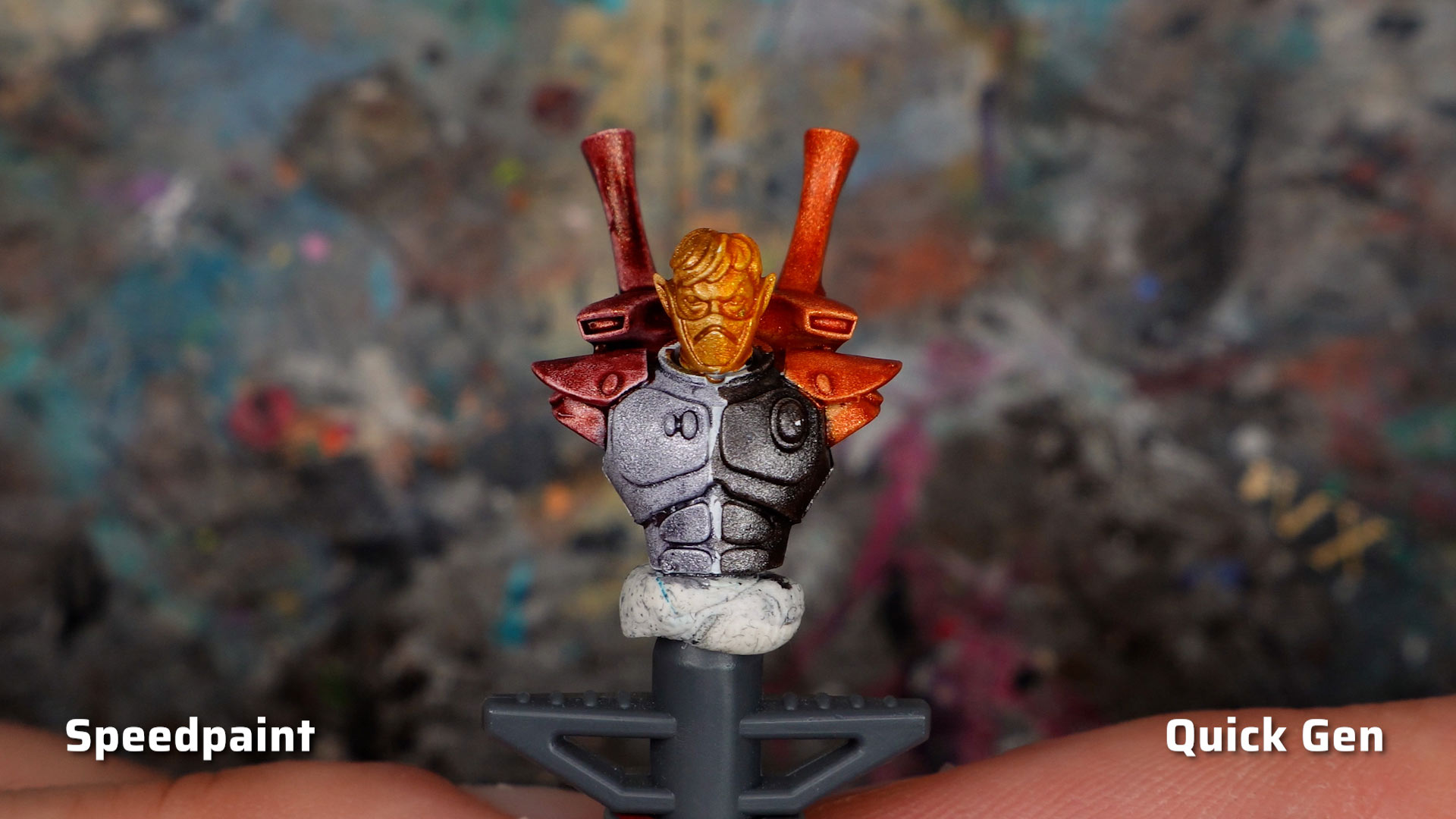Painting miniatures with just one coat – with this premise and promise, Citadel Contrast revolutionised the tabletop hobby in 2021, spawning multiple competing products like the popular Speedpaint from The Army Painter. And now AK, best known for their 3rd Gen acrylics, are coming along with their new Quick Gen paints. Took them long enough. Maybe even too long, considering the amount of competition that is already there. Well, I’ve tested all 80 Quick Gen paints and I’ll tell you if they were worth the wait. Can they outperform the others or are they just another me-too Contrast copycat?
I commit myself to review as unbiased as humanly possible. So, a quick heads-up: AK did send me and other selected painters prototypes during the development process and asked for our opinion. But I didn’t get any compensation for that, nor am I sponsored by AK or any other paint brand. If anything, I’ll be especially critical in this review, because they will be sorry if they haven’t listened to my feedback.
Quick Gen from AK – what makes them special?
For years I’ve been testing all the major new releases in the miniature paint world, and now I’ve got the brand new Quick Gen paints from AK right here. I’ve got the Quick Paint Combo set, which includes all 80 colours along with 20 3rd Gen acrylics and some brushes for drybrushing. There are also plenty of smaller sets as well as individual bottles.


But the elephant in the room is, did we even need Quick Gen since we already have Contrast, Dipping Inks, Instant Colours, Speedpaint, and Xpress Color. After all, all “one coat” paints are supposed to do the same thing: create shadows and highlights with just one layer over a light undercoat. So, can you really reinvent the wheel there? I mean with so many established competitors, you’ve got to stand out somehow.
For example, Dipping Inks from Green Stuff World are available in these huge 60ml containers, and Army Painter Speedpaint has loads of beginner-friendly paint sets and is now even available as markers. Make sure to check out my miniature paint markers video if you haven’t heard about these. But AK’s Quick Gen come in these standard 18 ml dropper bottles like everyone else. Might it be the price then?
So to get to the bottom of the question about what makes Quick Gen special, we need to dig deeper and take a closer look at the Quick Gen range. There are 79 colours plus a thinner medium, which is significantly more colours than what Contrast and Xpress Color offer, and almost as many as Army Painter’s Speedpaint. There are even 6 metallic Quick Gen paints amongst them, and that’s quite something, as so far only The Army Painter has metallic one-coat paints in their lineup. I’m really excited to test these out in a moment, but first, a word about the colour palette.


As for all my reviews, I’ve tested every colour individually and professionally digitised them. As you can see, there’s a great selection of vibrant colours as well as an extra Military subrange of uniform colours. The only thing missing would be some lighter skin tones and bone colours, but you can thin some of the darker colours with their Quick Gen medium for that.
In fact, many of the colours are very similar or identical to popular Contrast and Speedpaint colours, but there are also some unique ones like Reddish Flesh and Vampire Flesh. If you want to compare this with your existing collection, I recommend my 6-in-1 One Coat paint chart, which has all the colours from all six brands in one huge colour-ordered graphic:


This hand-painted swatch is available in my Patreon shop for a small donation (or by becoming an Autarch tier member). I also have swatches for Citadel, Vallejo Game and Model Color, Warpaints Fanatic, AK 3rd Gen and more – all cross-compatible with each other so you can compare colours across different brands. Check out my shop for details.
The solution for the Contrast problem
A criticism often heard about the Citadel Contrast range is that the individual colours have such different properties. Some are quite thin like a wash, others are very dark and intense, while still others dry very evenly and create little shading. It’s just unintuitive if you don’t know exactly how a colour behaves before buying it. Other one coat paints like Speedpaint also have a certain degree of variation.
But AK’s Quick Gen paints now found a solution to this problem. And it actually goes back to a suggestion I made when I tested the prototypes. Each colour from the main range has an intensity rating from low to high printed on the bottle.


- Low-intensity paints are somewhat more transparent, almost like a wash, similar to the lighter Contrast paints like Pylar Glacier or Plaguebearer Flesh, or like most Vallejo Xpress Colors.
- Medium-intensity Quick Gen paints behave like the average Contrast and Speedpaints, so a good balance between rich midtones and strong shadows and highlights.
- High-intensity paints correspond to particularly dark Contrast paints like Leviadon Blue, Cygor Brown, and the Vallejo Xpress Colors with the Intense label.
The rating is not perfect though, I found some of the high intensity colours behave more like medium intensity ones, but at least it gives you a general idea.
There is one thing to keep in mind though: the intensity rating doesn’t mean the same as opacity. Rather it describes the depth of the tint. This is because Quick Gen paints are free from additional white, opaque pigments. In other one coat paint ranges like Contrast and Speedpaint, there are some colours with a high proportion of white pigment. You can recognise these by the residue that forms at the bottom of the paint pot over time. These opaque pigments are a problem if you work with pre-shading, for example, zenithal basecoats or drybrushing for the Slapchop technique. This is because the bright opaque pigment will collect in the recesses of the model, which you want to remain dark. As you can see here, this can create a very unsightly effect. Since Quick Gen is free of white opaque pigment, they are more transparent and perfect for Slapchop.


By the way, in my 6-in-1 One Coat paint comparison chart, I’ve marked all the one-coat paints with a high proportion of opaque pigment so you can plan your paint schemes accordingly.
Quick Gen performance test
So far, so good, but I’m not entirely sure if the rating alone will make people want to chuck out their Contrast and Speedpaints and switch to Quick Gen. So, we now need to test how Quick Gen performs on a model and whether they can outperform the other competitors… or not.
For this, I’ll grab one of my Stahly test models, which my mate elfhead3D designed. I’ve simply primed it white, but you can also experiment with other light colours. I felt the Quick Gen paints flow very nicely from the brush. The consistency is comparable to Vallejo Xpress Colors I would say, and lies between the thinner Speedpaint and Citadel Contrast, which has a slightly higher viscosity. Of course, we’re talking about nuances here. But I find that Speedpaint is sometimes quite runny and a bit difficult to control. Please let me know in the comments about your experiences, but I found it can easily flow into neighbouring areas where you don’t want it to go because of the capillary action. Games Workshop’s Contrast, on the other hand, is easier to control as it stays more in its place, but as a result, it sometimes dries a bit patchier on flat areas.


For me, Quick Gen is the perfect middle ground, similar to Xpress Color from Vallejo. However, with Xpress Color, I sometimes have the feeling that the paint doesn’t pull back from the edges quite as well, which results in less pronounced highlights. Quick Gen, however, has no problems in this regard and performs just as well as Speedpaint and Contrast. This test model has a lot of flat areas, which one-coat paints always struggle with, but I think the result is quite decent. The finish is smooth and slightly satin, similar to Speedpaint. I’d say Quick Gen is less glossy than Contrast but not as matte as Vallejo Xpress Color.
Apart from the finish there is one more very important characteristic when it comes to one coat paints, which I’ll tell you about in a moment.
Testing the Quick Gen metallics
But first let’s have a look at the six metallic Quick Gen paints. Up until now, The Army Painter were the only ones who’ve got metallic one coat paints in their range, and there’s a good reason for that. One coat paints, like inks, are based on transparent dyes, and metallic paints contain opaque metallic particles. Now, usually, those two things are mutually exclusive, but The Army Painter have somehow managed to pull it off. However, it’s been a while since the Speedpaints were released, and I’m keen to see if AK has been able to improve what The Army Painter started.


And comparing them directly with the Speedpaint metallics, the shading effect of the Quick Gen metallics is slightly more pronounced. What’s more, the results are more consistent, except for Cold Steel, as my bottle was really thick. With the metallic Speedpaints, the results vary quite a bit depending on the colour; I found that some create noticeable shadows, while others stay rather flat. However, with Quick Gen, the metallic effect is more subtle in comparison, and the selection of only six colours is very limited. I’m particularly missing a bright silver.
So which brand you prefer is really down to personal taste. I reckon I find AK marginally better because the results are more consistent, but personally, I’d always go for proper metallic paints, as one coat metallics feel too much like a compromise to me. But with a bit of experimentation, you can definitely achieve some cool effects.
One coat paints: reactivation vs. stability
Let’s talk about the probably most important thing when it comes to one coat paints. You might have heard the word ‘reactivation’ in connection with The Army Painter’s Speedpaints. Actually the term ‘reactivation’ isn’t entirely accurate, but more on that in a moment. What people mean when they talk about reactivation is whether the one coat paint can be lifted off when dry or can even bleed through layers of paint applied over it. The first generation of Speedpaints from The Army Painter was very strongly affected by this issue, and I was one of the first to publicly criticise it.
But as I’ve come to understand, “reactivation” is actually not the accurate term as this effect is related to the curing time. The first generation of Speedpaint, due to its chemical composition, took a tremendous amount of time to fully cure, often several days or more, even though they were dry to touch. During this period, the paint could be lifted off with a damp brush or wet paint.
While some painters creatively utilized this for blending techniques, most people including me found this quite inconvenient. The Army Painter listened to the feedback and managed to almost completely remove this effect with the second generation of Speedpaint. But how do Quick Gen paints behave in this regard? Throughout my testing of the various prototype iterations, I paid particular attention to this aspect and gave a lot of feedback.
The Quick Gen stability test
So for the final retail versions of the Quick Gen paints, I ran the following test: I dabbed various colours onto some plasticard here and manipulated them after 20 minutes, 2 hours, and half a day of curing time.


Test number one was the damp brush test. Even when the colours were dry to touch after just 20 minutes, they were already quite resistant, and only the Orange Brown I managed to lift off a bit. After two hours curing time, it was hardly an issue anymore, and completely gone after 12 hours.


Then came the second test, where I painted over the dried Quick Gen with a light grey acrylic paint. And you can see here in the first row that the light grey discolours again on the Orange Brown, even after 12 hours of curing time. I mean it shouldn’t be a problem if you’re painting over with a similar colour, like a light warm brown in this case. But with light neutral colours like white and grey you have to be a bit careful and maybe apply a coat of varnish first.
All the same, I’d still rate the resistance of the Quick Gen paints as pretty good. The stability is a touch better than the current 2nd generation of Speedpaints and is on par with Vallejo Xpress Color. Games Workshop Contrast paints, however, are still the most stable one coat paints. Once they are dry to touch, they are already fully cured and completely resistant to external factors.
Value
A single 18ml bottle of AK Quick Gen has an RRP of €2.95 in Europe. That’s only half the price of an 18ml pot of Citadel Contrast and €1.40 cheaper than 18ml of Speedpaint from The Army Painter! This makes Quick Gen, along with the large 60ml bottles of Green Stuff World’s Dipping Inks, which I reviewed here, the most affordable one-coat paint range. However, you don’t really save anything with the various paint sets.
But which one coat paint range is the best now? Well, let me put it this way: on a tier list, I’d put Quick Gen quite high in the A tier. It’s close, but they might even have a slight edge before Speedpaint. You can find out how I would rank the other brands like Contrast and Xpress Color in this post.
You can find the latest hobby products at our 🇬🇧/🇪🇺 partner stores Wayland Games, Element Games, and Firestorm Games, at 🇩🇪 Taschengelddieb and PK-Pro, and at 🇺🇸 Noble Knight Games with a welcome discount of up to 10–15% over RRP. Using our links helps to support Tale of Painters at no additional cost to you, so thank you very much for using them!
I hope you found this review helpful, feel free to leave a reaction or comment below, or post your questions here or discuss on our Discord channel.
8.5 Score
Pros
- Great flow and "Contrast" shading properties
- Range includes a useful intensity rating system
- Very competitive price (at least in Europe)
Cons
- Don't reinvent the wheel when it comes to one coat paints
- The range of metallic colours is quite limited
Final Verdict
There is a lot to like about AK’s new Quick Gen range. Sometimes it pays to wait for others before releasing a product so you can learn from their experiences. However, I haven't found that one thing that makes Quick Gen stand out from the crowd. Perhaps Quick Gen is the sum of its parts – the well-balanced colour palette, the competitive price, and the above average performance and stability.








